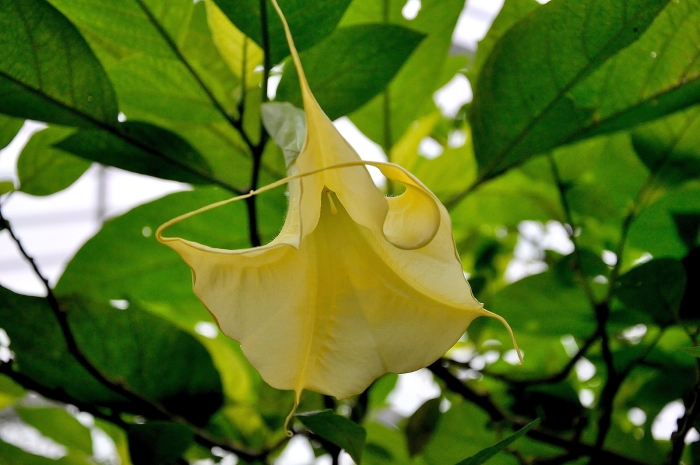Golden Angel’s Trumpet
(Brugmansia aurea)
Golden Angel’s Trumpet (Brugmansia aurea)
/
/

Paul Hermans
CC BY-SA 3.0
Image By:
Paul Hermans
Recorded By:
Copyright:
CC BY-SA 3.0
Copyright Notice:
Photo by: Paul Hermans | License Type: CC BY-SA 3.0 | License URL: https://creativecommons.org/licenses/by-sa/4.0 | Uploader: Paul Hermans | Publisher: Wikimedia Commons |































Estimated Native Range
Summary
Brugmansia aurea, commonly known as Golden Angel’s Trumpet, is an evergreen shrub belonging to the Solanaceae family. It is often mistaken as extinct in the wild; however, it is native to the Andes mountains of South America, where it thrives in cloud forests at high altitudes. This species can grow up to 20 feet (6.1 meters) tall, with a wide, spreading habit. The showy, pendulous, trumpet-shaped flowers are typically yellow or white and bloom from summer to autumn in the Northern Hemisphere, emitting a strong, sweet fragrance in the evenings, which attracts pollinators such as moths.
Golden Angel’s Trumpet is highly valued for its dramatic, large flowers and pleasant scent, making it a favorite in ornamental gardens. It is often used as a focal point or in containers that can be moved to protect the plant from cold temperatures. The plant prefers full sun to part shade and requires regular watering, but it is important to avoid waterlogged conditions. Well-draining soil is essential to prevent root rot. ’Grand Marnier’ is a popular cultivar with peach-colored blooms. While beautiful, all parts of Brugmansia aurea are toxic if ingested, and it should be handled with care. In some regions, it can become invasive if not managed properly.CC BY-SA 4.0
Golden Angel’s Trumpet is highly valued for its dramatic, large flowers and pleasant scent, making it a favorite in ornamental gardens. It is often used as a focal point or in containers that can be moved to protect the plant from cold temperatures. The plant prefers full sun to part shade and requires regular watering, but it is important to avoid waterlogged conditions. Well-draining soil is essential to prevent root rot. ’Grand Marnier’ is a popular cultivar with peach-colored blooms. While beautiful, all parts of Brugmansia aurea are toxic if ingested, and it should be handled with care. In some regions, it can become invasive if not managed properly.CC BY-SA 4.0
Plant Description
- Plant Type: Shrub
- Height: 20-30 feet
- Width: 12-16 feet
- Growth Rate: Moderate
- Flower Color: Yellow, Orange
- Flowering Season: Summer, Fall
- Leaf Retention: Evergreen
Growth Requirements
- Sun: Full Sun, Part Shade
- Water: Medium
- Drainage: Medium
Common Uses
Bee Garden, Bird Garden, Butterfly Garden, Deer Resistant, Fragrant, Hummingbird Garden, Showy Flowers
Natural Habitat
Native to the cloud forests of the Andes in South America
Other Names
Common Names: Borrachero, Culebra, Golden Angel’s-Trumpet
Scientific Names: , Brugmansia aurea, Brugmansia pittieri, Datura aurea, Brugmansia affinis, Datura affinis, Datura pittieri, Datura arborea subsp. aurea, Datura arborea var. aurea,
GBIF Accepted Name: Brugmansia aurea Lagerh.